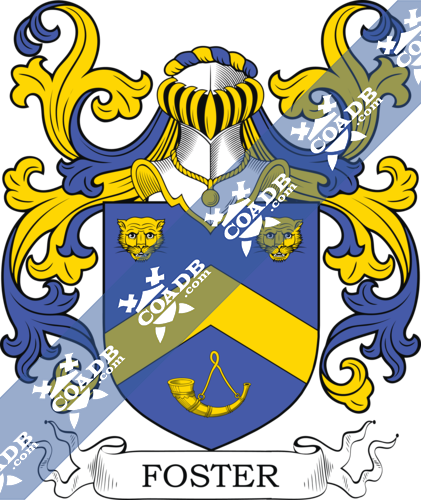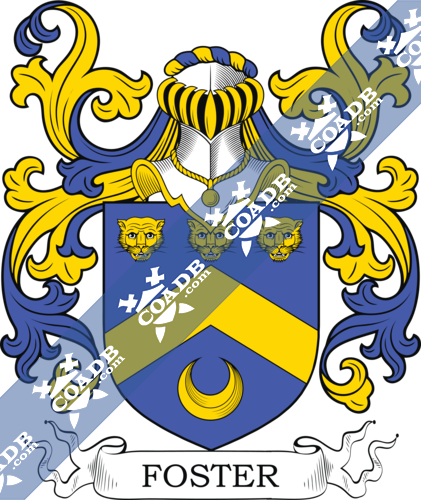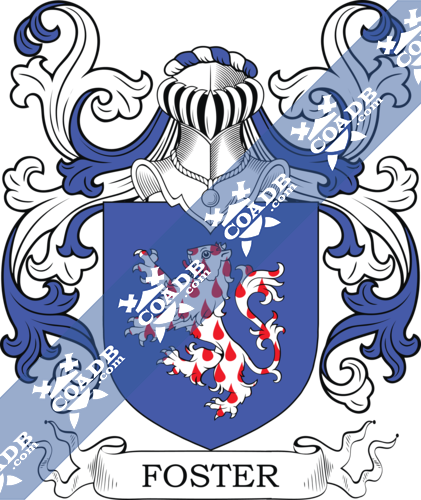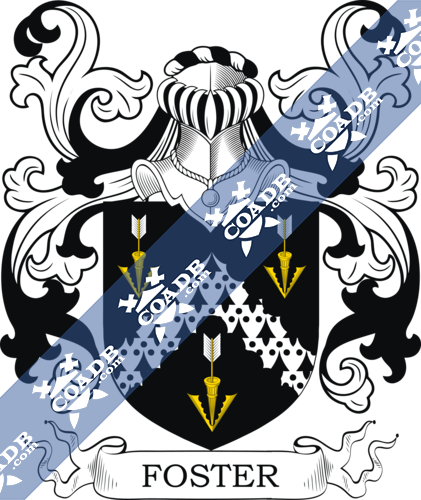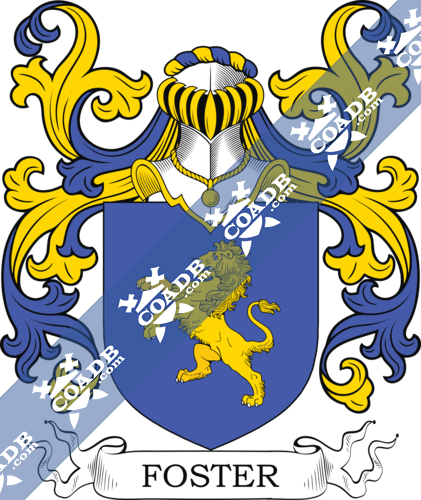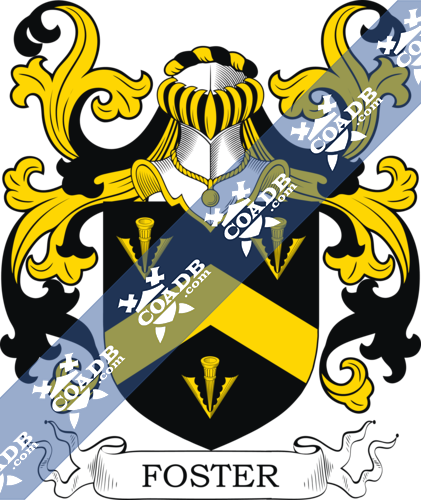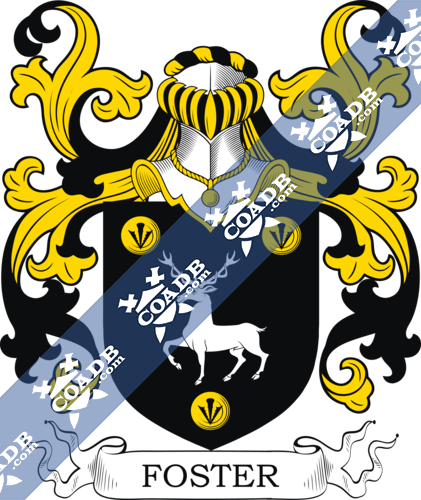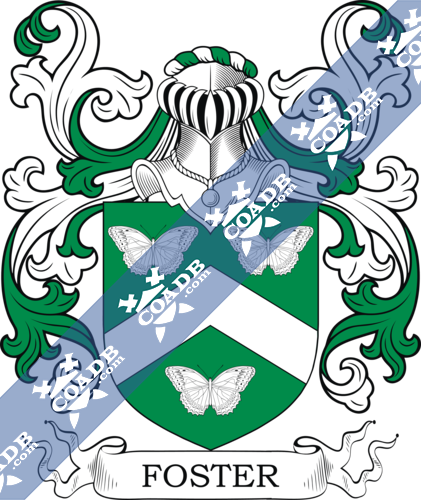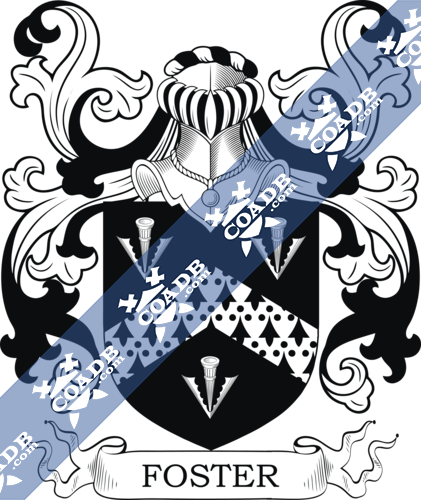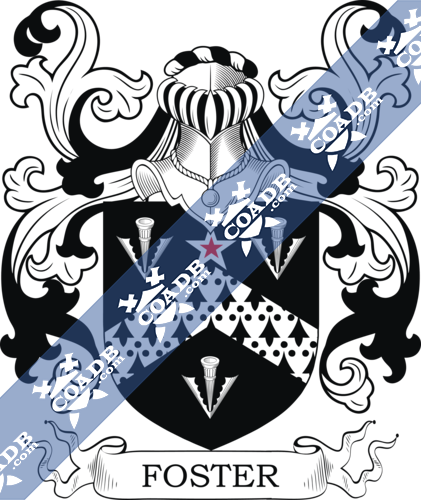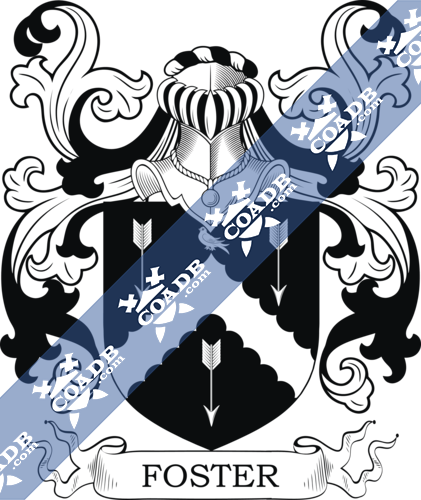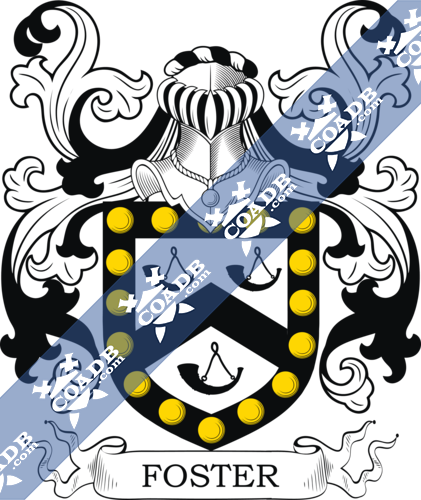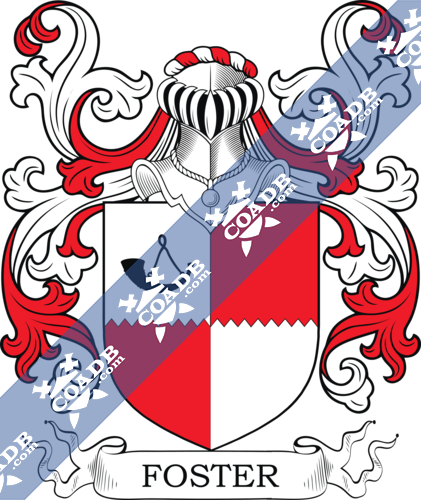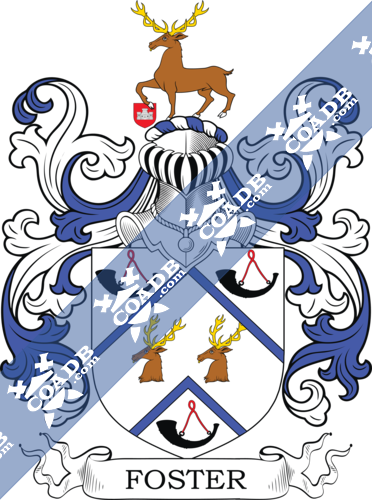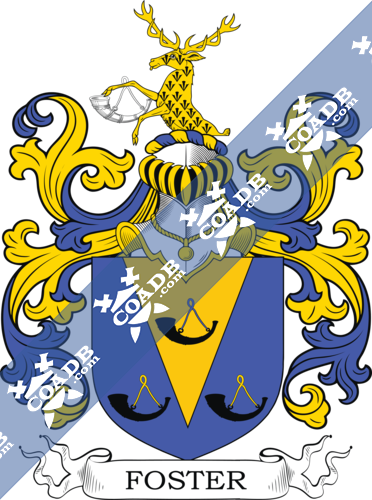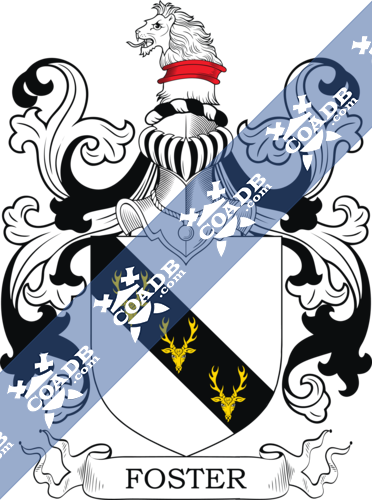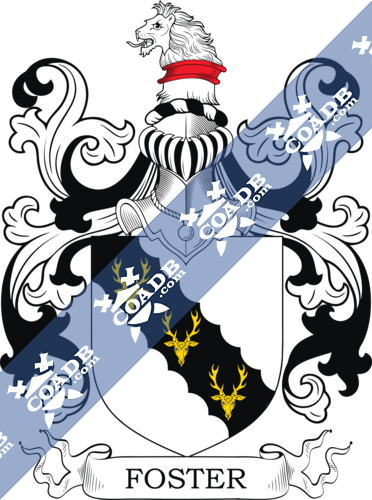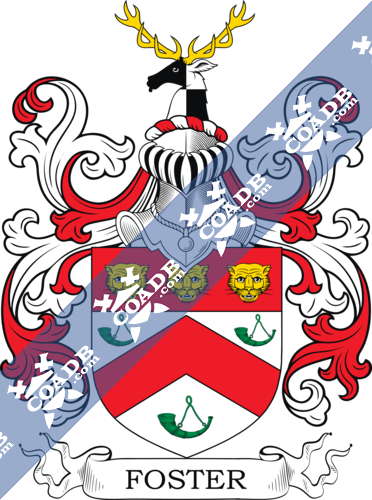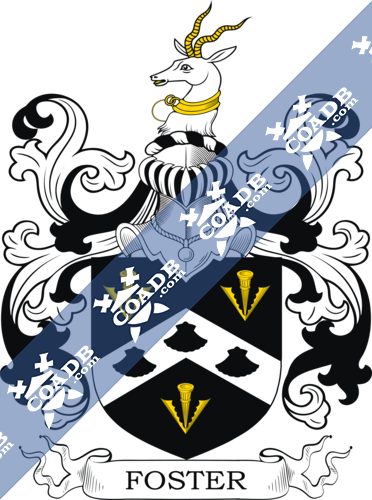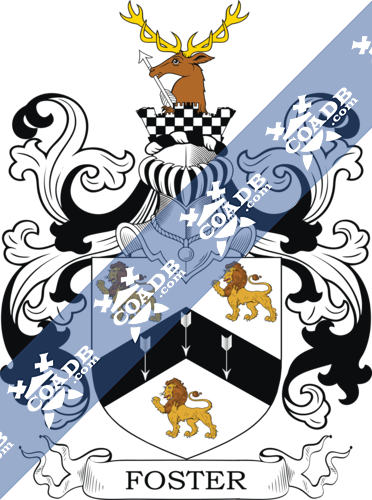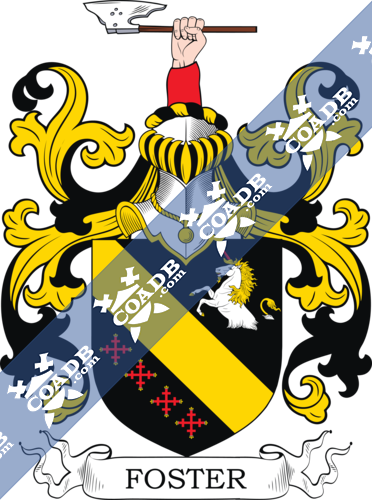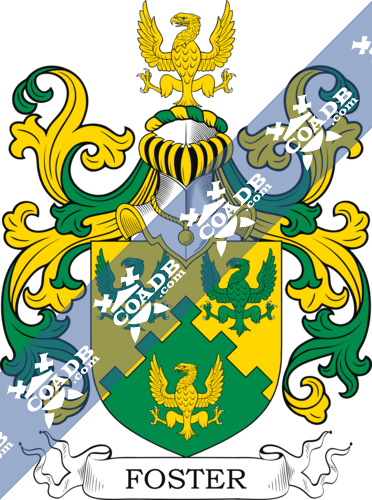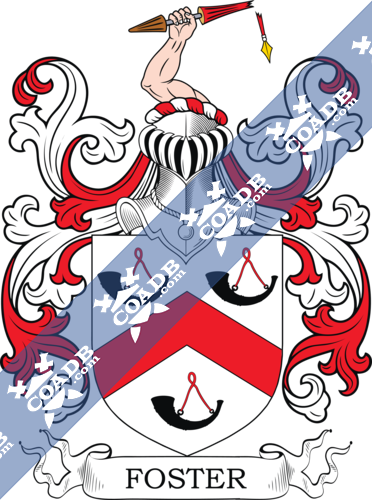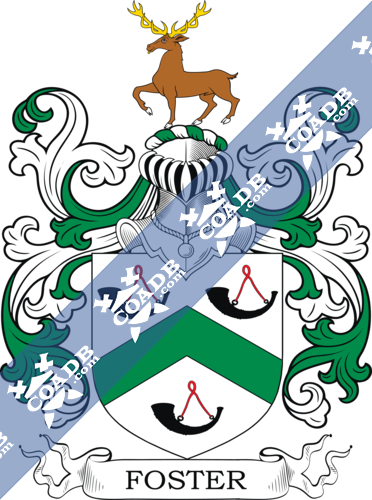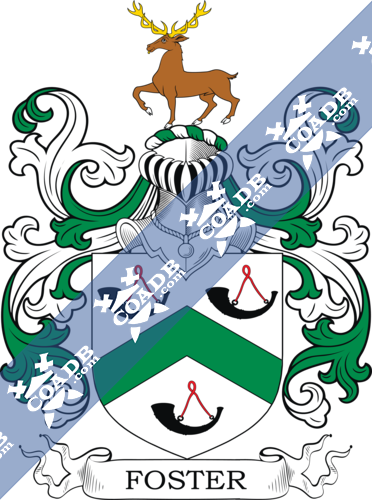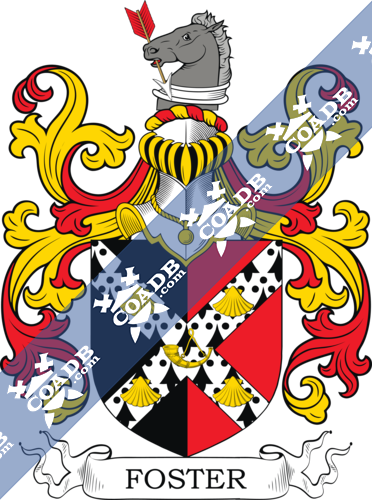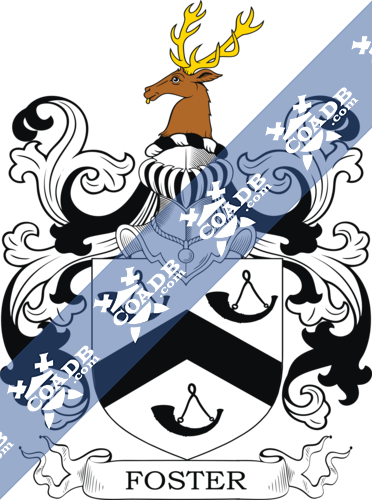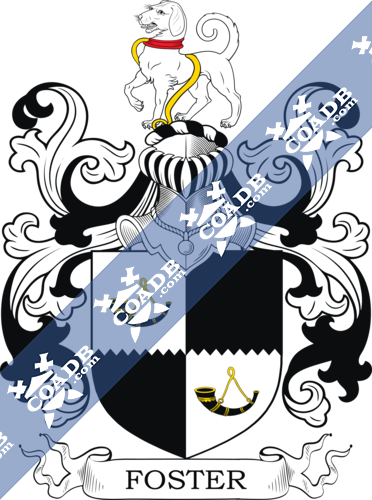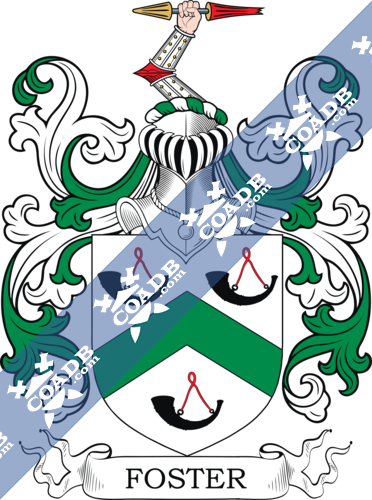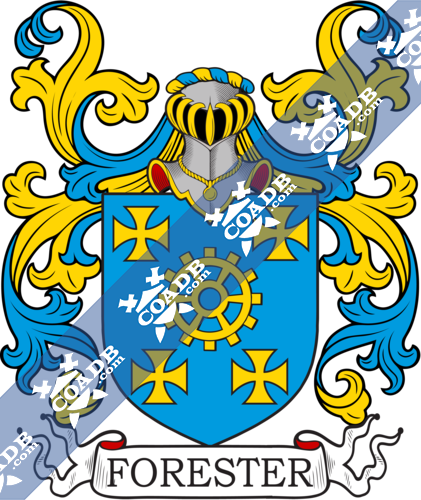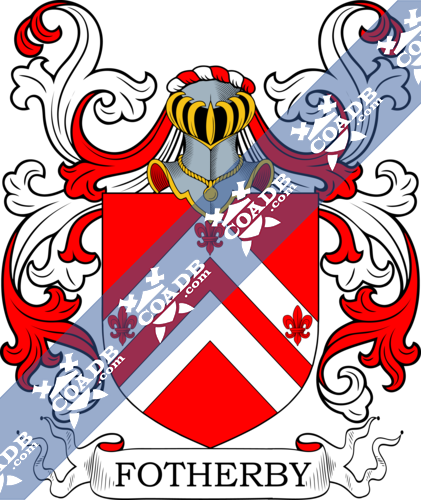Foster Family Crest, Coat of Arms and Name History
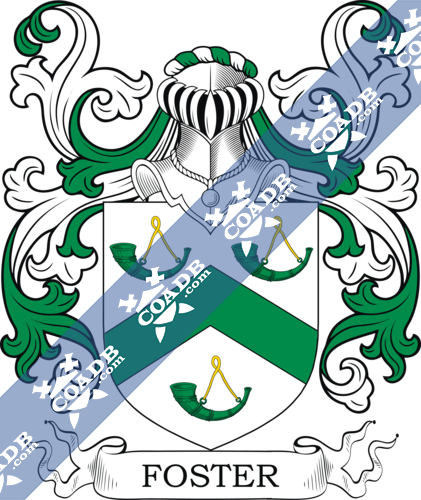
Foster Coat of Arms Gallery
Don’t know which Coat of Arms is yours?
We can do a genealogical research. Find out the exact history of your family!
Learn MoreSurname Name Meaning, Origin, and Etymology
This is an occupational surname meaning “the forester”, with Foster becoming the abbreviated version from early times. Today, a forester refers to who practices forester, the science or art of managing a forest through harvesting and restoration. However, in medieval times, a forester was a title roughly equal to that of a sheriff or a local law enforced who could act as barrister or arbiter. He was responsible for patrolling the woodlands of a noble or lord’s property, and he mainly stopped illegal hunting (poaching) and negotiated the sale of timber/lumber. Further, criminals and outlaws often sought refuge in the woods, and it was the foresters responsibility to organize armed posse to capture or disperse such criminals. Foster is also an abbreviation of the surname Forster. A second origin theory is that it is a nickname for a foster parent, deriving from the Middle English word foster or Old English fostre, meaning “to rear or nourish”. Third, it may be an occupational surname for a saddle tree maker, an important profession in the Middle Ages, which derives from the Old French word fustier (in turn a derivation of fustre), meaning block of wood. Hence, the name was brought into Britain from France during and after the Norman Invasion of 1066 AD. Fourth, it may be an occupational name for a person who made or used focetier, which are steel sheers used in the textile and agricultural production. One source asserts the family was first found in Northumberland in England.
Spelling Variations
Common spelling variants or names with similar etymologies include Forester, Forster, Foyster, Foister, Foester, Fosster, Forrester, Forrest, Fuster, and Forrestor. Similar foreign names include Fostier (Flemish). The Domesday Book of 1086 AD, a survey of England and Wales ordered by William the Conqueror, mentions Forst, a personal (first) name. The last name Vedast is the Latinized form of the name.
Popularity & Geographic Distribution
The last name Foster ranks 87th in popularity in terms in the United Status as of the 2000 Census. The name ranks particularly high in the following 15 states: Georgia, Michigan, Virginia, Missouri, Alabama, South Carolina, Indiana, Oklahoma, Arkansas, Oregon, Maine, Idaho, Alaska, Vermont, and Wyoming.
The surname Foster frequency/commonness ranks as follows in the British Isles: England (77th), Scotland (267th), Wales (161st), Ireland (185th) and Northern Ireland (185th). In England, it ranks highest in counties Nottinghamshire, Lincolnshire, and Yorkshire. In Scotland, it ranks highest in Selkirkshire and Fife. In Wales, it ranks highest in county Caernarfonshire. In Ireland, the surname Forester it ranks highest in Cavan. In Northern Ireland, it ranks highest in Fermanagh.
The name is also present throughout the remainder English speaking world: Canada (154th), New Zealand (112nd), Australia (122nd), and South Africa (601st).
The 1890 book Homes of Family Names by H.B. Guppy, states the following in regard to this surname: “This surname, in its two forms, is widely distributed over England, being however absent or rare in the three eastern counties of Norfolk, Suffolk, and Essex, and in the southwest of England. Forster is essentially the north country form, being especially numerous in Northumberland. Foster is the form characteristic of the rest of England, being particularly frequent in Notts. The north of England, however, is the principal home of the name, the two varieties occurring in Northumberland in the proportion of 107 per 10,000 of the population. Curiously enough, it has found no permanent home in Scotland”.
Early Bearers of the Surname
The earliest known bearer of this surname was Durand le Fuster who was documented in the Register of St. Bartholomew’s Hospital in London in 1179 AD. Another source asserts the earliest bearer was Hugh Forester, who was recorded in documents related to a Shropshire family bearing this name around the Wrekin Forest. John Forester was recorded in the Pipe Rolls of Surrey in 1183 AD. A one Rich le Forester was documented in the Feet Fines of Essex in 1240 AD. John Foster was listed in the Court Roll of Colchester, Essex in 1373 AD. The Hundred Rolls of 1273 AD, a census of Wales and England, known in Latin as Rotuli Hundredorum lists four bearers of this surname: Petrus Forestarius (Buckinghamshire), Jordan le Forester (Berkshire), Nicholas le Forester (county Lincolnshire). The Poll Tax of Yorkshire in 1379 AD lists five bearers of this last name: Benedictus Foster, Dionica Foster, Gilbertus Forester, Radulphus Forester, Wilelmus Forster, and Roger Forster. The Register of St. Mary Aldermary’s of London lists two bearers of this name, with professions being list as cutters, Robert Foster and Robert Forster, in 1643 AD.
George Fraser Black’s, The Surnames of Scotland, published in 1946, states the following in regard to the surname Foster: “a contracted form of Forrester. Patrick Fostar and John Fostar witnessed an instrument of sasine in 1488, and Alexander forester who witnessed a sasine of 1711 signed his name Alexander Foster”.
History, Genealogy, and Ancestry
The famous genealogist Bernard Burke’s books “The Landed Gentry” and “Peerage and Knights” discusses eleven branches of this family: 1) Foster of Apley Park, 2) Foster of Pontlands, 3) Foster of Clewer Manor, 4) Foster-Meliar of North Aston Hall, 5) Foster of Kempstone, 6) Foster of Brickhill, 7) Foster of Ballymascanlan, 8) Foster of Horton-in-Ribblesdale, 9) Foster and Wadworth, 10) Foster of Bloomsbury, and 11) Foster of Norwich.
Foster of Apley Park
William Orme Foster, Esquire of Apley Park Salop was Justice of the Peace, Deputy Lieutenant and a Member of Parliament for South Stafford, as well as a High Sheriff in county Wexford in 1876. Hr was born in 1819 and succeeded his uncle in 1853. In 1843, he married Isabella, daughter of Henry Grazebrook of Liverpool, and had the following issue with her: William Henry (married Henrietta Grace Mahon), James (Lieutenant Grenadier Guards), Charlotte (married Hector Stewart Vandeleur), Isabella, and Julia Mary. Burke traces the Foster genealogy back to Hugh Foster of Nantwich, who had a son named Henry. Henry was of Stourbridge and was born in 1743. He married Mary Haden, widow of Gabriel Bradley, with whom he had the following issue: William, James, Mary, and Lucy. Burke does not mention a blazon or armorial bearing for this branch of the family.
Foster of Pontlands
Joseph Foster, Esquire of Pontlands, Essex who was born in 1807 and in 1833 he married Elizabeth, daughter of James Thomasin of Witham, and had one surviving son: James Thomasin, LL.D. who attended St. Peter’s College Cambridge who was born in 1832. He was a Barrister-at-Law of the Middle Temple and a Magistrate for Essex. In 1856, he married Jane, daughter of John Furmedge. Burke traces the lineage of this branch of the family tree back to George Foster, who in 1776, married Susannah, daughter of Daniel Hevery. He had a son with her named Joseph who was an Essex of Power’s Hall. In 1804, Joseph married, Susannah, daughter of Stephen Clement of Panfield, and had a son with her named Joseph Foster, Esquire of Pontlands. This seat was in Great Baddow, Chelmsford. Burke does not mention a blazon or armorial bearing for this branch of the family.
Foster of Clewer Manor
Edmund Benson Foster was an Esquire of Clewer Manor, Windsort, and Berks who was born in 1824 and was a Justice of the Peace. In 1874, he married Edith Eleanor, daughter of Thomas Fraser Grove of Fern, and had two issue with her: Evelyn Grace Mary (1876) and Florence Constantia Cicely (1877). Burke traces the Foster genealogy back to Richard Foster, an Esquire, who in 17771, married Constantia, daughter of Sir Edward Baynot Rolt, of Spyke Park, and had issue with her: Baynton (1777), 2) Richard (1780), Frederic (1785), Augustus (1787, married Letitia Billet), Constantia, Caroline (1793, married James Elmslie). His youngest son was Edmund Foster was born in 1791 and in 1818 he married Maria, daughter and heiress of Arthur Benson of New Crofts, and had two issue with her: Edmund Benson and Eliza Constantia.
Foster-Meliar of North Aston Hall
William Melliar Foster-Melliar was an Esquire of North Aston Hall in county Oxford who was Justice of the Peace for counties Somerset and Oxford, as well as High Sheriff of the latter in 1865. He was born in 1836 and in 1857, he married Louisa Elizabeth, daughter of Reverend Charles War, A.M., Rector of Maulden. Burke traces the lineage of this branch back to Andrew Foster Esq., son of Reverend Edward Foster and Mary Tudway, and assumed the additional surname of Melliar in 1840. In 1835, he married his first cousin, Elizabeth, daughter of Reverend Aaron Foster, and had four issue with her: William Melliar (mentioned above), Robert (Lieutenant 20th Regiment), Andrew (married Catherine Lucretia Dewsbury), and Rose (married Reverend Arthur Barwell). The Foster Coat of Arms (erroneously called the Forster Family Crest) for this branch is blazoned as follows in heraldry: Argent, three marlets gules, on a chief dancette azure, an annulet or, between two fleurs-de-lis of the field. Crest: In front of a lion’s gamb erect and couped or, holding a branch of myrtle proper two mascles interlaced fessways azure.
Foster of Kempstone
Reverend Frederic Adolphus la Trobe of Kempstone in county Bedford and The Bogue in Lancaster Estates, Jamaica, was born in 1820 and was Rector of Little Munden. In 1849, he married Annie Hulbert, daughter of Reverend William Read of Stone Easton, and he had six children with her: Reverend Frederic La Trobe, Henry Read, Annie Louisa (married Edward Daw), Carolina Nora, Helen Mary, and Leila Kate. Burke traces the Foster ancestry back to an ancient and distinguished house of Forster or Foster of Ethersone Castle, Lucker, and Bamborough Castle in Northumberland. Tradition states the progenitor was William de Forestier, a Norman Cavalier, who came into England with William the Conqueror during the Norman Conquest of 1066 AD. A one Thomas Forster was born in 1397. He had a son also named Thomas who married into the Featherstonhaugh family and he in turn had a son named Thomas, who married the sister of the Blind Baron of Hilton, and he also had a son named Thomas. This fourth Thomas was Sir Thomas Forster, who was a High Sheriff of Northumberland in 1564 to 1572. He married Dorothy, daughter of Lord Ogle, and he had a son also named Thomas. This Thomas, in 1518, married Frances Wharton. He had a brother named Sir John Forster, who was a prominent military leaders in the feuds between the Scottish and English Borderes, and was Governor of Bamborough, and Warden of the Middle Marches. John married Jane, daughter of Sir Cuthbert Radclyffe. He had a daughter naked Eleanor (married Sir Francis Russell) and a son named Nicholas. His son, Sir Nicholas Foster, was Lord of Blanchland and Governor of Bamborough married Jane, daughter of Sir Anthony Ratcliffe, and he had a son named Sir Claudius Forster, a Baronet. Claudius married Elizabeth, daughter of Sir William Fenwick and had a son with her named Sir William. The pedigree continues in great detail for several generations. The Foster Coat of Arms (erroneously called the Foster Family Crest) has the following heraldic blazon: Argent, a chevron vert between three bugles sable stringed gules. Crest: An arm in armour embowed, holding the head of a broken tilting spear all proper.
Foster of Brickhill
Morgan Hugh Foster, Esquire of the Bogue Lancaster, and the Two Wood Estates, Jamaica and of Brickhill, ear Bedford. He was Commissioner of Land Tax and principal Financial Officer of the Treasury who was born in 1815. In 1838, he married Mary, daughter of George Flint, Esquire and had surviving issue: Algernon Crauford (1839), Edward (1841), Arthur (1843), and William Erksine (1847), Alice, Edith Margaret, and Florence Amelia. The lineage of this family is the same as the Kempstone Branch down to John Foster, who was of the Bogue Estate, Jamaica, and of Brickhill House, Bedfordshire, Lord of the Manor of Marston, Magistrate for England and Jamaica who was born in 1765. He married three times. His first wife was Margaret, daughter of Thomas Place, and he had four children with her: William, Thomas, Edward, and Margaret (married Reverend Maurice Farrel, Rector of Woughton). His second wife was his cousin, Flora Foster. His third wife was Amelia, daughter of John Morgan, with whom he had the following children: Algernnon, Arthur Fitz-John, Morgan Hugh, Mary Amelia (married Reverend Henry Fuller), and Flora (married Reverend Alfred Dawson). His son and heir was Arthur Fitz-John Foster who was a Member of the House of Assembly. He was born in 1813 and died in 1842, whereupon he was succeeded by his brother, the Morgan Hugh mentioned at the beginning of this paragraph. They bore the same heraldic arms are Foster of Kempstone.
This section also mentions the Foster-Barham branch. Joseph Foster, Esquire, son of Colonel John, was born in 1729. He took the name Barham and married twice: first to Dorothea, daughter and heiress of Erasmus Vaughan, and Lady Hill of Hawkestone. The eldest son from the first marriage was John Foster-Barham, Esquire of Trecwn and of Stockbridge, who was born in 1760 and was a Member of Parliament for that borough. In 1792, he married Lady Caroile Tufton, daughter of the 8th Earl of Thanet. Burke continues with the lineage for two more paragraphs.
Foster of Ballymascanlan
Frederick John Foster was an Esquire of Ballymascanlan in county Louth, Ireland, who was Justice of the Peace, Deputy Lieutenant, and High Sheriff in 1845. He was born in 1788 and in 1827 he married Isabella, daughter of Peter Vere. Burke traces the Foster genealogy of Foster ancestry back to William Foster, Esquire, Member of Parlaiment for Dunleer, the son of Reverend Thomas Foster, and the nephew of Anthony Foster, Lord Chief Baron of Ireland. In 1743, he married Patience, daughter of John Fowke, and had four children with her: John William (Member of Parliament for Duneleer, married Rebecca McClure), Henry, Patience (married John McClinctock), and Elizabeth (married John Longfield). This branch bore the following Foster Coat of Arms (erroneously called the Foster Family Crest): Argent, a chevron vert between three bugles sable stringed gules. Crest: A stag passant proper.
Foster of Horton-in-Ribblesdale
John William Foster was an Esquire of Horton-in-Ribblesdale in county York who was born in 1812. He was Deputy Lieutenant and in 1842, he married Anne, daughter of Thomas Ingleby, and had six children with her: Thomas (late Lieutenant 63rd Regiment), Bryan Hesleden (Captain in the 44th Regiment, married Isabella Robinson), John (married Ethel Anne Clark), William (married Martha Rebecca Marriner), Alice (married Thomas Theophilus Secundus Metcalfe), and Florence (born 1860). Burke traces the Foster lineage of Foster genealogy/ancestry back to a family long settled in the region with the first ancestor recorded to history being Thomas Foster, a Gentleman, who had a son named Thomas. The son Thomas married and had two issue: Thomas and William (Gentlemen of Stainfort who married Grace Johnson). This branch of the family descends from the former son Thomas. This branch bore the following Foster Coat of Arms (erroneously called the Foster Family Crest): Argent, a chevron between three buglehorns very stringed gules. Crest: A stag’s head argent.
Foster and Wadworth
Henry Foster was an Esquire of Wadsworth Banks and Falling Royd in county York who was Justice of the Peace and was born in 1795. Burke traces the lineage of this branch of the Foster family tree back to a family that came from Wensleydale, North Riding of county York, around 1500. This family purchased the estate/manor/lands of the Slack near Heptonstall (which at the time Burke’s book was written was possessed by John Foster, who married the daughter and heir of Henry Lord). John Foster, Esquire of Slack, a son of Thomas, married Elizabeth, daughter of Thomas Greenwood, built a chpel at Slack and preached within in. He had a daughter and three sons: John, Henry, and William. Henry Foster, Esq. moved to Wadsworth Bank around 1770. He married Anne Townsend, and had a daughter with her named Mary (died at age 73 without posterity) and John, Esquire of Wadsworth Bank who was born in 1790. He married Sarah, daughter of William Howorth of White Lee) and had a daughter named Elizabeth (who died young) and a son and heir named Henry Foster (mentioned above). He died in 1812 at the age of 51. Burke does not list a coat of arms or blazon in heraldry for this family. They were seated at Wadsworth Bank and also Falling Royd, county York.
Foster of Bloomsbury
Sir Thomas Saxby Gregory Foster, 2nd Baronet of Bloomsbury, county London was educated at Marlborough and he served in World War I as a Lieutenant in the R.F.A. and in World War II as a Lieutenant Colonel in the South African Artillery was born in 1899 and succeeded his father in 1931. In 1925, he married Beryl, daughter of Alfred Ireland of Cradock, and had two issue with her: John Gregory (1927) and Barbara Maude (1929). The lineage/ancestry traces back to Reverend Thomas Foster who had a son named Thomas Gregory Foster. Thomas was of Cavendish House, Clapham, Surrey, and was a Barrister-at-law. He was born in 1815 and in 1858, he married Sophia, daughter of John Farquar Allday of Birmingham and have several issue with her, including: 1) Sir Thomas Gregory (created a Baronet 1930), 2) William Arthur John (born 1870, married Helen Sowerby Wallis), 3) Alfred Edye Manning (born 1874, married Elanor Margaret Elizabeth Franks). The eldest son, Sir Thomas Gregory Foster, was born in 1866 and created a knight in June of 1917 and a Baronet in 1930. He held a Ph.D. and was Vice-Chancellor of the University of London, among other achievements and titles. He married Fanny Maude, daughter of James Sledge of Hove) and had four children with her: Thomas Saxby (mentioned at the beginning of this paragraph), Lewis Marshall Gregory (married Margaret Amy Tillard), Margaret Gregory (married Arthur Loraine Lawford of Mortimer), and Helen Morley Gregory (married Arthur Loraine Lawford of Mortimer).
Burke does not list a coat of arms for this family. This branch of the Foster family tree resided at The Country Club Corrage, Auckland Park, Johannesburg, Transvaal, South Africa.
Foster of Norwich
Sir William Yorke Foster, 3rd Baronet, was born in 1860 and succeeded his father in 1911. He was in the Militia of the City of Norwich and a Colonel in the Army and served in the South African War (1899-1900) and World War I. In 1885, he married Aileen Ethel, daughter of Colonel Augustus Berkeley Portman of Bombay) and he had the following issue with her: William Augustus Portman (Captain South Staffs Regiment), Henry William Berkeley (Major 10th Service Bn. Northumberlas Fus, served in World War I), Aileen Cavendish (married Dwight Carlton Harris), Frances May (Lieutenant-Colonel Hugh Auriol Stanton), Dorothy Harlie (married Major James Gerard Berkeley Portman Graham), and Georgina Patricia. Burke traces the lineage to William Foster of Norwich, son of William Foster and Mary Harper. This William married Sarah, daughter of Robert Pratt, and had a son named William. This William was born in 1762 and in 1787, he married Mary, daughter of Jehosaphat Postle and later Anastatia, daughter of John Beevor, and had issue with her: Reverend Lambert Blackwell of Brundall (married Mary Greene Browne), William, and Anastasia (married Giobanni Pietro Giulio Francesco Cucchi and later Ernesto Baldassare Luigi Penotti Picmonte). The second son, Sir William Foster, 1st Baronet of Norwich was born in 1798 and was created a Baronet in 1838. In 1821, he married Mary Anne, daughter of Starling Day (a banker in Norwich) and had two issue with her: William (2nd Baronet) ,Charles (Clerk of the Peace, married Charlotte Wills), Francis Gostling (born 1830, married Lucy Gwyn and later Bertha Steward). The Foster Coat of Arms (mistakenly called the Foster Coat of Arms) is blazoned in heraldry as follows: Argent, two bucks’s heads erased proper, within two chevronels azure, the whole between three bugle-horns sable, stringed gules. Crest: A buck proper, the dexter fore-paw resting on an inesocheon gules, charged with a castle argent.
Early American and New World Settlers
Patience Foster, age 40, came to New England in April 1635 aboard the Elizabeth.
Hopestill Foster, age 14, came to New England in April 1635 aboard the Elizabeth.
Sylus Foster, age 22, came to Virginia in June 1635 aboard the Thomas & John.
Christopher Foster, age 32, and his wife, Francis Foster came to New England in June 1635 aboard the Abigail, along with their three children: Rabecca, Nathaniel, and Joseph.
James Foster, age 21, came to Virginia in June 1635 aboard the America.
Richard Foster, age 21, came to Virginia in August 1635 aboard the Safety.
Francis Foster, age 18, came to Virginia in August 1635 aboard the George.
A one John Foster was recorded as living in Virginia 1623 AD.
The name was also present in the Caribbean. William Foster, son of William, was baptized in 1678 in the parish of St. James, Barbados. Doctor Robert Foster, who owned 7 acres of land and 5 slaves, was documented in the aforementioned parish in the same here. Thomas Foster, age 27, came to Bermuda in June 1635 aboard the Truelove.
The book Genealogical Guide to the Early Settlers, mentions
1) Reginald (or Renold) Foster who was from Ipswich, who came in 1639 and he had a land grant in 1641 and brought with him Abraham, William, Isaac, Jacob, and two daughters. He had a second wife named Judith and he had issue with her: Judith, Mary, and John. He had a third wife, Sarah Martin, with whom he had the following issue: Ruth, Ellen, Hannah, and Nathaniel.
2) William Foster of Boston, 1644, had a wife named Susanna, moved to Charletown and married his second wife Ann, daughter of William Brackenbury, and had the following issue with her: Ann, Mary, Elizabeth, Deborah AND John. He died in 1698 at the age of 80.
3) Thomas Foster of New London, called in the record of John Forster, of Kingsware. In 1666, he married Susanna, daughter of Ralph Parker, and had the following issue with her: Susanna, Thomas, Jonathan, Mary, Edward, Samuel, Rebecca, and Ebenezer. He died in 1685.
4) Hopestill Foster of Dorchester, 1634, had a wife named Patience, who came in the Elizabeth at the age of 40 her son. He was a freeman in 1639, a part of an artillery company in 1642, and a selectman in 1645.
5) Christopher Foster of Lynn, who came in the Abigail 1635, aged 32, with wife Frances, 23 , and had issue named Rebecca, Nathaniel, and John. He was a freeman in 1637 and moved to Long Island, New York.
6) Bartholomew Foster of Gloucester, who married Hannah, daughter of Thomas Very in 1669. He had issue with her: Bartholomew (1670), John (1673), Thomas (1676), Samuel (1678), Edward (1681). He died in 1682
7) Edward Foster of Scituate about 1633, two years later married Lettice Hanford, and had issue with her: Timothy (1636), Timothy , and Elizabeth.
8) Edward Foster of Springfield, in 1661, married Esther Bliss, who lived in the family of John Pynchon, and was a freeman in 1690. He died in 1720.
9) Samuel Foster of Wenham was a freeman 1650, moved to Chelmsford. In 1655, with wife Ester, he had Edward, Esther, Hannah, Samuel, and Eli. He was a representative in 1679. He died in 1702 at the age of 82.
10) Thomas Foster of Weymouth was a freeman in 1647 and had issue Thomas, John, and Increase
11) Thomas Foster of Roxbury who married Sarah, daughter of Robert Parker, in 1662 and had the following issue with her: Thomas, Thomas, Sarah, Hannah, Jonathan. He was a freeman in 1666.
Early settlers in colonial America bearing this name who came in the early eighteenth century were Daniell Foster (Virginia 1700), Thomas Foster (Virginia 1714), Phillis Foster (Virginia 1714), Julian Foster (Virginia 1717), and Samuel Foster (South Carolina 1728). In Canada, some of the earliest bearers of this surname were Bennet, Edward, and Patrick Foster, who came to Nova Scotia in 1750. One of the earliest bearers in Australia was William Foster, a convict from Middlesex, England who came to Van Diemen’s Land (modern day Tasmania) aboard the Albion in May of 1823. Some of the earliest bearers of this last in New Zealand were James Ramsay Foster (aboard the Coromandel) and John Foster who to the city of Wellington in 1840.
Early Americans Bearing the Foster Family Crest
I researched the following three resources and did not find any coats of arms for Foster: Bolton’s American Armory, Matthew’s American Armoury and Bluebook, and Crozier’s General Armory.
Charles Bolton’s American Armory (1927) contains eight entry for this surname:
1) Arg 3 hunting horns sa. On a chief wavy vert an eagle rising. Bookplate Charles Chauncy Foster. R. D. Weston-Smith, del. 1900
2) Arg a chev purpure bet 3 hunting horns, stringed sa. Crest: a stork. Motto: To rock the cradle of reposing age. Bookplate Nathaniel Foster. J. M. Furnas, sc.
3) Arg a chev bet 3 hunting horns stringed [sa]. Engr. plate from Abigail, wife of John Foster of Boston to Second Church, Boston, 1711. Old Sil. Am. Ch., p. 42.
4) Arg a chev vert bet 3 buglehorns sa, stringed gu. Crest: an arm in armor embowed, holding in the hand a broken tilting spear ppr. Motto: Si fractus fortis. Tombstone, Sarah, wife of Richard Foster, Jr. [ 1724], Old Burial Ground, Charlestown, Mass. Also on tankard owned by Edward I. Browne, Boston. Here they are beautifully engraved in colors. Vermont’s Amer. Heral., pp. 137, 165. Heral. Jour., vol. 1, p. 56.
5) Arg a chev vert bet 3 hunting horns sa. Engr. to show the colors on a large tankard owned in 1865 by Edward I. Browne of Boston. Heral. Jour., vol. 1, p. 56.
6) Arg a chev bet 3 stringed hunting horns [sa] and on a chief 3 leopards’ faces. Crest: an armed arm embowed, holding a broken tilting spear. Upright slate stone of James Foster, who d. 1732, aged 82, and Anna, his wife, who d. 1732, aged 68. Dorchester, Mass., Burying Ground, Dudley St.
7) [Or] 3 bugle horns [vert] stringed [gu]. On a chief wavy az a dove wings addorsed arg in its beak a twig of olive [or].Crest: on an upturned bugle horn garnished [or] a popinjay with wings addorsed ppr. Motto: Ubi libertas. Embr. on upper right corner of a sangaibushi or christening cloth for Kate Montgomery Foster, daughter of Andrew and Kiku (Kanai) Foster of Yokohama and Boston. Surrounded by pine, plum, and bamboo in gold thread, signifying happiness. Upper left Fujiyama for high ideals. Lower right a white stork flying and gold clouds for long life. Lower left Kanai crest of gold in a broad gold circle: 3 semi-octogon cubes one above another, partially super-imposed. Blue cloth bordered with Turkey red crepe. Owned by Miss Kate Foster (Mrs. Walter W. Purdue) Kuji Machi Ku, Tokyo.
8) Quarterly per fess dancettée arg and sa. In 1 and 4 a hunting horn sa stringed or. Crest: a stag’s head erased. Motto: Invidam virtute vincam. Bookplate Ingham Foster.
Crozier’s General Armory (1904) contains one entry for this name: Reginald Foster of Ipwich, Massachusetts, 1638, from Essex, England. Argent, a chevron between three bugle horns stringed sable. Crest: A dexter arm vambraced and embowed, the hand grasping a broken tilting spear proper.
Matthew’s American Armoury (1907) and Bluebook contains one entry for this name: James Foster, of Dorchester, MA. Argent, a chevron gules between three bugle horns very, on a chief of the second as many leopards’ faces or. Crest: An arm embowed in armour holding a spear proper.
Mottoes
We have identified eleven Foster family mottoes:
1) Industria, meaning “Industry”
2) Meret qui laborat, meaning “He is deserving who is industrious”
3) Si fractus fortis, meaning “Strong though broken” (an allusion to the broken spear in the crest)
4) Virtute et labore, meaning “By valour and exertion” (Foster of Norwich)
5) Praemium honor, meaning “The reward is honour”
6) Divini gloria ruris, meaning “The glory of the heavenly abode”
7) Orando te aspiciam, meaning “In praying I will look to thee”
8) Invidam virtute vincam, meaning “Envy surpassed (?)”
9) Ubi libertas, meaning “Where there is freedom”
10) Cupio meliora, meaning “To long for” or “I want better”
11) To rock the cradle of reposing age
Grantees
We have 43 coats of arms for the Foster surname depicted here. These 43 blazons are from Bernard Burke’s book The General Armory of England, Ireland, and Scotland, which was published in 1848. The bottom of this page contains the blazons, and in many instances contains some historical, geographical, and genealogical about where coat of arms was found and who bore it. People with this last name that bore a Foster Coat of Arms include:
1) Goddard Foster of Iden, Sussex, by Cooke, 1577, hart’s head; by Camden, talbots’ head 1602
2) John Badsley Foster, Hampshire, confirmed, 16 November 1557
3) Mary, see Forster
4) Samuel, B.D., of Redgrave, Suffolk, 24 May 1678, by W. Dugdale and H. St. George, Norr.
Pedigree from First Foster Ancestor
Tracing the pedigree or genealogy of this family leads back to the original ancestor: Ronald “Ingelram” de Neustria, a European noble, who was born around 800 AD. It should be noted this piece of information was obtained utilizing user input on the genealogy website wikitree.com, so it must be taken with a grain of salt. His lineal male descendants were as follows, with the numbers referring to the successive generations:
1) Audacer “Odacre, Odoscer, Odakar, Roland, Harlebec” de Flandre (born 810 in Flanders or France)
2) Baudouin (Baudouin I) “Baldwin , Count of Flanders, Comte de Flandre (born 837 in Belgium)
3) Baudouin II or Baldwin II (Flanders, 864 AD)
4) Arnoul (Arnulf I) “the Old, the Great” Flandre (Ghent 889 AD)
5) Baoudoin, Baldwin III, “the Young, the Bald” Flandre aka d’Artois, Count of Flanders, van Vlaanderen
6) Arnulf (Arnulf II) “le Jeune, the Young, Count of Flanders” (born 961)
7) Baudouin (Baudouin IV) “Baldwin, the Bearded, le Barbe” Flandre (980 AD)
8) Baudouin (Baldwin V) “the Pious, Count of Flanders” (born about 1012 AD)
9) Richard “Gilbert, William of Buckton, the Forester” Forster formerly Flandre (1034 Flanders)
10) Sir Hugo Forster of Northumberland
11) Reginald Forster
12) William Forster (born 1126 AD)
13) John Forster (born 1155 AD)
14) Sir Ranulph Forster
15) Sir Alfred “the Generous” Forster (born before 1265 AD)
16) Sir Reginald “John” Forster (born in Bamborough, Northumberland, 1284 AD)
17) Richard “John” Forster (before 1328)
18) William “John, of Bukton” Forster (born 1371 in Durham)
19) Sir Thomas Forster, Esq. (born in East Riding, Yorkshire, before 1388 AD)
20) Sir Thomas II “Lord of Etherstone” Forster (born in Durham, England before 1397 AD)
21) Sir Thomas III Forster (born before 1413 in Northumberland, England)
22) Sir Thomas IV Forster or Foster (born around 1450 in Etherstone, Northumberland)
23) Sir Thomas V Foster (formerly Foster) (born around 1480 in Adderstone)
24) Sir Thomas VI (born before 1519)
25) Ralph Forster (born 1552)
26) William Forster (born around 1575 in Newcastle-upon-Tyne)
27) William Forster (1630)
28) John Forster (born in Huntingon, England in 1672)
29) John Forster (born 1713)
30) John Forster (born in Norfolk before 1746)
31) Captain Henry Forster (born in London, England in 1789)
32) Major John Forster (born in Kent, England in 1826)
33) Henry William Forster (born in Southhampton, England in 1866)
34) Second Lieutenant John Forster (born 1893, member of Kings Royal Rifle Corps, killed in WW1)
Notables
There are hundreds of notable people with the Foster surname. This page will mention a handful. Famous people with this last name include: 1) Abiel Foster (1735-1806) who was an American clergymen and statesmen who represented New Hampshire in the Continental Congress during the American Revolution and its aftermath, 2) Abby Kelley Foster (1811-1887) who was an American abolitionist from Pelham, Massachusetts who worked closely with William Lloyd Garrison, 3) Sir Robert Sidney Foster (1913-2005) who was a British colonial administrator who served as the last colonial Governor of Fiji, 4) WilderDe Ayr Foster (1819-1873) who was a politician born in Orange County, NY who became the Mayor of Grand Rapids, Michigan State Senator, and a member of the U.S. House of Representatives from Michigan, 5) Vincent Walker Foster Jr. (1945-1993) who was Deputy White House Counsel during the early months of the Clinton Administration, 6) Stephen Clark Foster (1820-1898) who was the first American Mayor of Los Angeles and later served on the Los Angeles County Board of Supervisors, 7) Stephen Clark Foster (1799-1872) who was a representative from Maine in the U.S. House of Representatives, 8) Andrew “Rube Foster” (1879-1930) who was an American baseball player born in Calvert, Texas who became a pioneering executive in the Negro leagues, 9) John Foster (1740-1828) who was an Anglo-Irish peer and politician who was Chancellor of the Exchequer of Ireland and Speaker of the House of Commons in Ireland who became the 1st Baron Oriel, 10) James F. Foster who is a founder and commissioner of the Arena Football League and was also a former USFL and NFL executive, and 11) Major General Harry Wickwire Foster (1902-1964) who was a Canadian Army officer from Halifax, Nova Scotia who commanded two divisions of soldiers during the Second World War in both the European and Pacific theatres.
Blazons & Genealogy Notes
1) (co. York). Ar. a chev. betw. three buglehorns vert stringed or.
2) (Rev. John Foster, Rector of Foxearth, near Sudbury, co. Suffolk). Ar. a chev. gu. betw. three buglehorns vert, on a chief of the second as many leopards’ faces or. Crest—A stag’s head, quarterly, sa. and ar. attired or.
3) Ar. a chev. gu. betw. three buglehorns sa. stringed of the second. Crest—An arm embowed, holding a broken tilting spear ppr.
4) (Copdock, co. Suffolk). Ar. three buglehorns stringed sa.
5) Ar. a chev. vert betw. three buglehorns, and a bordure sa. bezantee.
6) (co. Berks). Ar. a chev. betw. three buglehorns stringed sa. Crest—A stag’s head erased ppr.
7) (Green Street, co. Kent, Watling Street and Sutton Maddox, co. Salop). Quarterly, per fesse indented ar. and sa. in the first and fourth quarter, a buglehorn of the second, garnished and stringed or. Crest—A talbot pass. ar. collared gu. lined or, nowed at the end.
8) Quarterly, per fesse indented ar. and gu. in the first quarter a buglehorn sa.
9) (Brickhill, co. Beds, and The Bogue, co. Lancaster). (The Bogue Estate, Jamaica, Egham, Kempstone, co. Beds; this family, long connected with the Island of Jamaica, is descended from the ancient house of Forster, or Foster, of Barnborough Castle, co. Northumberland). Ar. a chev. vert betw. three bugles sa. stringed gu. Crest—An arm in armour embowed, holding in the hand the head of a broken tilting-spear ppr. Motto—Si fractus fortis.
10) (co. Northumberland). Az. a chev. or, in chief two leopards’ faces and in base a buglehorn of the last.
11) (co. Northumberland). Ar. on a chev. vert three leopards’ faces or.
12) (co. Northumberland). Az. a chev. betw. three leopards’ faces in chief and a crescent in base or.
13) (Norwich, bart.). Ar. two bucks’ heads erased ppr. betw. two chevronels az. the whole betw. three buglehorns sa. stringed gu. Crest—A buck ppr. the dexter forepaw resting on an inescutcheon gu. charged with a castle ar. Motto—Virtute et labore.
14) (Anstey Hall, co. Cambridge; granted to Ebenezer Foster, Esq.). Az. on a pile betw. two buglehorns in base stringed or, another buglehorn stringed of the field. Crest—A demi stag or, semee of pheons and holding betw. the legs a buglehorn az. Motto—Praemium honor.
15) Ar. on a bend sa. three bucks’ heads cabossed or. Crest—A lion’s head erased ar. collared gu.
16) (co. Essex). Same Arms, the bend wavy.
17) (Iden, co. Sussex; Fun. Ent., 1639, Margaret, dau. of John Foster, Esq., and wife of Thomas Harding, of Maryborough, Queen’s Co.). Same Arms, the bend engr.
18) (cos. Essex and Suffolk). Az. (another, gu.) a lion ramp. ar. guttee de sang (another, de l’armes).
19) (co. Huntingdon). (Lord Mayor of London, 1434). Sa. a chev. erm. betw. three pheons ar.
20) (cos. Lincoln and York). Sa. a chev. engr. erm. betw. three broad arrows or, feathered ar.
21) (Wich, co. Worcester). (Dowsby, co. Lincoln). Sa. on a chev. ar. betw three pheons or, as many escallops of the field. Crest—An antelope’s head erased ar. attired, armed, and collared or, a line and ring flowing from the front of the collar gold.
22) (Barbadoes). Ar. on a chev. sa. betw. three lions pass. ppr. as many arrows of the field. Crest—Out of a mural crown chequy ar. and sa. a buck’s head ppr. attired or, in the mouth an arrow of the first.
23) Az. a lion ramp. or.
24) Sa. (another, gu.) a chev. (another, engr.) betw. three pheons or.
25) Sa. a buck trippant ar. betw. three bezants, each charged with a pheon of the field.
26) (London). Same Arms, a border gobony or and gu.
27) Az. a cross sarcelly betw. four crosses formee or.
28) (Wadsworth Banks, and Heptonstall Slack, near Halifax). A bend or, betw. a demi unicorn erased in chief, and four crosses crosslet flory in base. Crest—A cubit arm erect, vested, holding in the hand a battle axe fesseways.
29) (descendants of the late Rev. Robert Foster, Prebendary of the Cathedral Church of Wells). Per chev. embattled or and vert, three eagles displ. counterchanged. Crest—An eagle displ. or.
30) Vert a chev. betw. three butterflies volant ar.
31) (Ireland; Reg. Ulster’s Office). Sa. a chev. erm. betw. three pheons, points downwards ar.
32) (Alderman John Foster, Mayor of Dublin, from the Fun. Ent., 1640, of his dau. Margaret, wife of Christopher Bisse, Remembrancer of the Court of Exchequer). Same Arms, in chief a mullet ar. charged with another gu. for diff.
33) (Stonehouse, co. Louth, bart.). (Ballymaescanlan, co. Louth). Ar. a chev. vert betw. three buglehorns sa. stringed gu. Crest—A stag pass. ppr. Motto—Divini gloria ruris.
34) (granted to Henry Foster. Esq., of Coomie Castle, co. Cavan). Ar. a chev. vert betw. three buglehorns sa. stringed gu. Crest—A stag pass. ppr.
35) (Lanwithan, Lostwithiel, co. Cornwall). Per pale sa. and gu. on a saltire erm. a bugle horn betw. four escallops. Crest—A horse’s head, couped collared ar. thereon three escallops in the mouth an arrow point downwards.
36) (Weeke, co. Somerset; Christopher Foster, temp. James I., son of John Foster, and grandson of William Fostes, of Reading, a younger brother of William Foster, Esq., of Aldermaston, co. Berks. Visit. Somerset, 1623). Sa. a chev. engr. betw. three arrows inverted ar. a martlet for diff.

